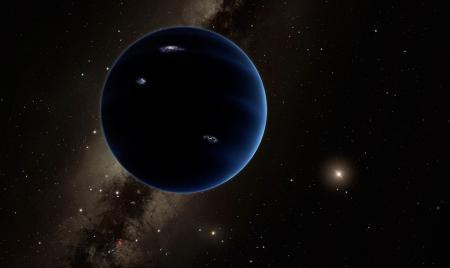Planet 9: If it exists, how did it end up at the edge of our Solar System?

There is evidence to suggest there is a mystery planet lurking at the edge of our Solar System – but if it does exist, how did it end up there? Researchers from the Harvard-Smithsonian Center for Astrophysics (CfA) have studied several different scenarios for where Planet 9 came from, all of which are unlikely.
Scientists have long speculated there is an unknown planet sitting at the edge of the Solar System. However, earlier this year researchers at the California Institute of Technology said they had found evidence to support this idea. They said the unusual orbital patterns of a group of Kuiper belt objects could best be explained by a giant planet gravitationally dominating that region of space.

With mounting evidence to suggest Planet 9 does indeed exist, scientists have put forward four scenarios to explain where it came from. "The evidence points to Planet 9 existing, but we can't explain for certain how it was produced," says CfA astronomer Gongjie Li, lead author on one of the three studies submitted to the Astrophysical Journal Letters.
Planet 9 orbits the Sun at between 40 billion to 140 billion miles. This is far beyond any of the other planets in the Solar System. To explain its position, scientists ran computer simulations to look at three ways the planet ended up where it has.
In the first, Planet 9 was pulled outwards by a passing star, which had a stronger gravitational pull on it than the Sun. This would have tugged the planet into a wider and more elliptical orbit. As the Sun was born in a cluster of stars, the likelihood of another star passing nearby in the Solar System's early history is the most plausible explanation. However, the simulations revealed the chance of this happening is only 10%, as a star would probably pull Planet 9 out of the Solar System completely.
In another simulation, run by CfA's Scott Kenyon, scientists said Planet 9 may have formed much closer to the Sun. After interactions with Jupiter and Saturn, the planet was effectively kicked out to its current position. A third scenario involves Planet 9 forming at the far reaches of the solar system in the first place. The team said under the right conditions, the hypothetical passing star (mentioned earlier) would be enough for it to be pushed into its current orbit.
A final, and very unlikely scenario, involves Planet 9 being an exoplanet that either pulled into the orbit by a passing star, or drifted into the orbit by accident. This likelihood of this scenario is 2%, however.
Whether or not the planet even exists is still in question, however. As Jim Green, director of Nasa's Planetary Science Division, said earlier this year: "The possibility of a new planet is certainly an exciting one for me as a planetary scientist and for all of us. This is not, however, the detection or discovery of a new planet. It's too early to say with certainty there's a so-called Planet X. What we're seeing is an early prediction based on modelling from limited observations. It's the start of a process that could lead to an exciting result."
© Copyright IBTimes 2025. All rights reserved.






















